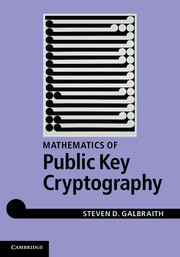Book contents
- Frontmatter
- Contents
- Preface
- Acknowledgements
- 1 Introduction
- PART I BACKGROUND
- PART II ALGEBRAIC GROUPS
- PART III EXPONENTIATION, FACTORING AND DISCRETE LOGARITHMS
- PART IV LATTICES
- PART V CRYPTOGRAPHY RELATED TO DISCRETE LOGARITHMS
- PART VI CRYPTOGRAPHY RELATED TO INTEGER FACTORISATION
- 24 The RSA and Rabin cryptosystems
- PART VII ADVANCED TOPICS IN ELLIPTIC AND HYPERELLIPTIC CURVES
- Appendix A Background mathematics
- References
- Author index
- Subject index
24 - The RSA and Rabin cryptosystems
from PART VI - CRYPTOGRAPHY RELATED TO INTEGER FACTORISATION
Published online by Cambridge University Press: 05 June 2012
- Frontmatter
- Contents
- Preface
- Acknowledgements
- 1 Introduction
- PART I BACKGROUND
- PART II ALGEBRAIC GROUPS
- PART III EXPONENTIATION, FACTORING AND DISCRETE LOGARITHMS
- PART IV LATTICES
- PART V CRYPTOGRAPHY RELATED TO DISCRETE LOGARITHMS
- PART VI CRYPTOGRAPHY RELATED TO INTEGER FACTORISATION
- 24 The RSA and Rabin cryptosystems
- PART VII ADVANCED TOPICS IN ELLIPTIC AND HYPERELLIPTIC CURVES
- Appendix A Background mathematics
- References
- Author index
- Subject index
Summary
The aim of this chapter is to briefly present some cryptosystems whose security is based on computational assumptions related to the integer factorisation problem. In particular, we study the RSA and Rabin cryptosystems. We also present some security arguments and techniques for efficient implementation.
Throughout the chapter we take 3072 bits as the benchmark length for an RSA modulus. We make the assumption that the cost of factoring a 3072-bit RSA modulus is 2128 bit operations. These figures should be used as a very rough guideline only.
The textbook RSA cryptosystem
Box 24.1 recalls the “textbook” RSA cryptosystem, which was already presented in Section 1.2. We remind the reader that the main application of RSA encryption is to transport symmetric keys, rather than to encrypt actual documents. For digital signatures we always sign a hash of the message, and it is necessary that the hash function used in signatures is collision resistant.
In Section 1.3 we noted that the security parameter κ is not necessarily the same as the bit-length of the RSA modulus. In this chapter it will be convenient to ignore this, and use the symbol κ to denote the bit-length of an RSA modulus N. We always assume that κ is even.
As we have seen in Section 1.2 certain security properties can only be satisfied if the encryption process is randomised.
- Type
- Chapter
- Information
- Mathematics of Public Key Cryptography , pp. 485 - 512Publisher: Cambridge University PressPrint publication year: 2012
- 2
- Cited by



